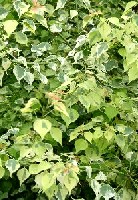View crop
View crop Data sheet EcoPortSapium sebiferum
 |
|
| Notes |
|---|
| DESCRIPTION: Fast-growing perennial deciduous tree. USES: Chinese tallow tree is cultivated for its seeds as a source of vegetable tallow, a drying oil and protein food, and as an ornamental. Fruits yield two types of fats: outer covering of seeds contain a solid fat with low iodine value, known as Chinese Vegetable Tallow; kernels produce a drying oil with high iodine value, called Stillingia Oil. Tallow is used for manufacturing candles, a layer of wax being placed over the tallow body to prevent too rapid burning; has excellent burning quality, and gives an inodorous clear bright flame; also used for making soap, cloth dressing and fuel. KILLING T.: In the dormant state the tree may be frost resitant down to -10°C for brief spells. COMMON NAMES: Chinese tallow tree, Tallow tree, Chinese vegetable tallow tree, Soap tree, Popcorn tree, Pau de sebo, Tarcharbi shishum, Pahari shishum, Arbol de la cera. FURTHER INF.: Scientific synonyms: Triadica sebifera, Excoecaria sebifera, Vilayati shisham, Stillingia sebifera, Croton sebiferums. Found at elevations between sea level and 2000 m. Can reach a height of 12 m. The species is indigenous to subtropical areas of central South China. Usually occurring at latitudes below 32°N. Optimum annual wood production is 26 m3/ha, on coppice rotations of 4 years. Mentioned as a possible agroforestry species. The tree can be an aggressive weed, the seeds are spread widely by birds, and once established it is very difficult to eliminate. The sap (latex) is a powerful irritant that blisters the skin. | Sources |
| Troup R 1921 pp 846 [KTMP, LIG, RAIN, DRA, USE] Roecklein J 1987 pp 339 [USE, DRA] Duke J 1975 pp 26 [PH, RAIN, TEMP] National RC 1983c pp 46-49 [DRA, SAL, KTMP, TEMP, RAIN, FER, USE] Hensleight T 1988 pp 385 [RAIN, TEXT, USE] |